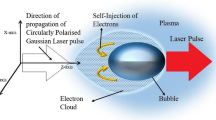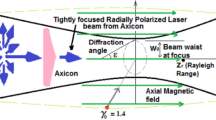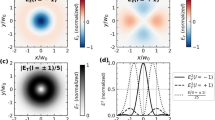Abstract
Comparative study of electron acceleration by linearly polarized (LP) and circularly polarized (CP) Hermite-cosh-Gaussian lasers in vacuum has been analyzed. Hermite-cosh-Gaussian profile is a special kind of Gaussian profile whose decentered parameter (b) plays a crucial role in the electron acceleration. It has been observed that the electron energy enhancement for CP laser pulse is much higher as compared to LP laser pulse for optimized values of laser parameters like laser intensity parameter (a0), laser spot size (r0), etc. It is seen from the results that maximum electron energy gain increases rapidly with the increase in the value of decentred parameter for CP laser. The electron enhances more rapidly with propagation distance z for CP laser pulse. This energy enhancement persists continuously for the successive increment of the laser spot size (r0) and b. The laser mode index is also responsible for the electron energy enhancement. The plotted graphs also reveal that the energy enhancement is higher for CP laser pulse as compared to LP laser pulse for different parameters.
Similar content being viewed by others
Avoid common mistakes on your manuscript.
Introduction
Many frontier research regimes have been opened up due to the rapid advancement of intense laser technology in recent years. Compact short pulse terawatt laser systems have been made possible with constant improvement in laser systems [1, 2]. In this regard, the laser electron interaction depends on the intensity distribution of the selected laser beam. According to Hartemann et al. [3], electron’s kinetic energy remains lower where lower-intensity regime enhances at higher-intensity region. This is due to the fact that electron experiences better trapping owing to intense laser field. Many researchers presented theoretical and experimental schemes to attain higher energetic electrons due to the aid of ultra-intense lasers [4,5,6]. The energy enhancement for Hermite–Gaussian (HG) laser beams much encounters experimentally and theoretically in laser and plasma physics in different-different conditions. One decade earlier, researchers have observed self-focusing of dark hollow Gaussian electromagnetic beams in plasma [1,2,3]. Various studies depict the electron acceleration due to Gaussian laser due to its potential to produce narrow beams of reduced divergence with restricted energy spread [7, 8]. Carbajo et al. [9] have experimentally observed direct electron acceleration due to radially polarized (RP) laser beam and achieved highly directional longitudinal accelerating gradients above the GeV/m range. Several researchers have also analyzed the behavior of the HG laser beam. The higher-order corrections are derived and studied for the electron acceleration by tightly focused HG beam in vacuum [10]. For HG modes in the cavity, in case of inhomogeneous intensity distribution, the comparison of standing waves of conventional Fabry–Perot cavities and the cavity’s compactness led to different scaling for laser parameters compared to conventional mode-lock lasers [11].
Self-focusing of HG laser beams in plasma under plasma density ramp becomes much strong as the propagation distance increases [12]. The strong self-focusing occurs when the HchG beam propagates deeper inside the nonlinear medium as the spot size shrinks due to highly dense plasma [13]. Ghotra and Kant [14] have investigated electron acceleration due to CP HG laser and highlighted the utility of intensity distribution of TEM modes and laser beam width parameter of this laser on electron energy gain. The solutions obtained from Maxwell’s equations were constructed in terms of the paraxial scalar wave equation (done experimentally) for the polarization structure of HG laser beams [15]. HG beams have large numbers of applications also they used for air vehicle communication systems in vertical paths of weak atmospheric turbulent medium [16]. In this paper, we employed a HChG laser beam for efficient electron acceleration in a vacuum. In the laboratory, we can create such a profile using Gaussian, Hermite–Gaussian, and cosh-Gaussian beams. As a result, the HChG beam is the generic kind that encompasses all of the above beams. The HChG profiles have a lot of advantages in the laser–plasma interaction because they have more adjustable parameters like the Hermite polynomial mode indexes (order) and the decentered parameter, which provides more control over the self-focusing phenomenon. The higher-order modes of the Hermite–Gaussian beams, on the other hand, have a particular intensity distribution that forces a better electron trapping at the focus than the Gaussian mode beam.
In the present manuscript, we have analyzed the comparative study of CP and LP HchG laser pulse in vacuum for improved electron energy gain. In this study, it has been observed that for CP HchG laser pulse the energy enhancement is higher as compared to LP HchG laser pulse. The electron energy dependence is analyzed laser decentered parameter b and pz0, and energy enhancement is observed with higher value of decentered parameter.
Electron dynamics
Consider the propagation of a HchG laser with electric and magnetic field as given below:
Here, \(\phi = \omega t - kz\) is the initial phase of laser, s is the mode index associated with the Hermite polynomial Hs, E0 is the amplitude of HchG laser beam for central position at \(r = z = 0\), \({\text{r}}_{0}\) is the initial spot size of the laser, and b is the laser’s decentered parameter and \(r^{2} = x^{2} + y^{2}\) Here, \(\alpha = 0\) for LP laser pulse and \(\alpha = 1\) for the CP laser pulse; the magnetic field concerned with the laser is calculated by Maxwell’s equation,\(\nabla \times {\mathbf{E}} = - {\raise0.7ex\hbox{${\partial {\mathbf{B}}}$} \!\mathord{\left/ {\vphantom {{\partial {\mathbf{B}}} {\partial {\text{t}}}}}\right.\kern-\nulldelimiterspace} \!\lower0.7ex\hbox{${\partial {\text{t}}}$}}\).
The electron’s momentum and energy can be calculated from the equation \({\raise0.7ex\hbox{${{\text{d}}{\mathbf{P}}}$} \!\mathord{\left/ {\vphantom {{{\text{d}}{\mathbf{P}}} {{\text{d}}t}}}\right.\kern-\nulldelimiterspace} \!\lower0.7ex\hbox{${{\text{d}}t}$}} = - e\left( {{\mathbf{E}} + {\mathbf{v}} \times {\mathbf{B}}} \right)\) and \(\gamma^{2} = 1 + (P_{x}^{2} + P_{x}^{2} + P_{x}^{2} )/m_{0}^{2} c_{0}^{2}\) using the relativistic Newton–Lorentz equations of motion. The electron momentum and energy can be deduced from the following equations:
These Eqs. (5)–(8) have been solved by fourth-order Runge–Kutta (RK-4) method with variable time step size using MATLAB software. Here, \(\gamma\) is the Lorentz factor, Px = γm0vx, Py = γm0vy, Pz = γm0vz. Throughout this paper, we normalized time by 1/ω, length by 1/k and velocity by 1/c. We have used the following normalized parameters, a0 = \(e\) E0/m0ωc, where \(e\) is the electronic charge and m0 is the rest mass of electron.
Results and discussion
Figure 1a–b depicts the variation of electron energy γ with the laser initial intensity parameter a0 with different values of electron’s initial velocity vz0. The normalized values of vz0 are taken as 0, 0.5 and 1.0 for different values of laser’s decentered parameter or modal parameter b. The comparison has been made for CP and LP HchG laser for effective electron energy gain. Hermite-cosh-Gaussian (HchG) beam can be generated in the laboratory by the superposition of two decentered Hermite-Gaussian beams as cosh-Gaussian ones. HchG laser beam focuses earlier than any other laser beams. That is why it is very much effective to transfer energy to electrons. The self-focusing of HchG laser beam can be controlled by the mode indices and the decentered parameter, as the decentered parameter is more sensitive to self-focusing.
Figure 1a, b shows the effect of initial electron velocity \({v}_{z}\) on electron maximum energy gain for fixed values of initial beam waist, decentered parameter and Hermite order. The variation of maximum energy gain (\({\gamma }_{m}\)) with normalized intensity parameter (\({a}_{0}\)) at an optimum value of laser beam waist width (\({r}_{0}\)) = 50, decentered parameter (b) = 1 and Hermite order or index (s) = 1 keeping the z component of electron velocity \({v}_{z}=0\) and 0.4, respectively, for LP and CP HchG laser beam has been plotted. From the graphs, it is evident that electron’s maximum energy gain is more pronounced for CP HchG laser beam than that of LP HchG laser beam. The ponderomotive force is a function of intensity distribution of laser’s electric field, due to which electron is captured by laser more effectively and oscillates in its electromagnetic field. In the leading edge of the laser pulse, electron enhances its energy, and in the trailing edge of the laser pulse, electron’s energy is almost saturated. In case of pre-accelerated electron, transfer of energy from laser pulse to electron occurs smoothly. Due to axial symmetry, electron can gain more energy in case of CP laser beam in comparison with LP laser beam. It has been noticed that with an increase in the intensity parameter (\({a}_{0}\)), the \({\gamma }_{m}\) increases along the direction of propagation of the beam. The maximum energy gain for CP laser with electron initial velocity, \({v}_{z}=0.4\) is approximately 84% enhanced as compared to LP laser for similar set of parameters.
Figure 2 depicts the variation of electron’s energy (\(\gamma\)) in MeV with normalized time (\({t}^{^{\prime}}\)) for the fixed value of \({a}_{0}=5, 10\) and 15, respectively, and z component of velocity \({v}_{z}=0\) and 0.5 in each case. Other parameters like \({r}_{0}=50, b=1, s=1\) are same for other plots. At optimum value of laser parameters, initially pre-accelerated electron interacts with laser pulse: When electron interacts with the rising part of the laser pulse, electron gains its energy and on the falling part of laser pulse electron’s energy is saturated. As we increase intensity of laser beam, electron spends more time with laser’s electromagnetic field; as a result, interaction time increases and the longitudinal force is increased on the electron, and hence, electron gains significant energy and retains the same gained energy for both longer duration and distance.
Decentered parameter of laser plays a crucial role on electron acceleration as depicted in Fig. 3. In these graphs, we have shown the variation of maximum energy gain (\({\gamma }_{m}\)) in MeV with decentered parameter. The values of ‘b’ are varied from 0.5 to 2.5 with an interval of 0.5. Figure 3a is for \({a}_{0}=15\), \({r}_{0}=100\), \(s=1\), \({v}_{z}=0\), whereas Fig. 3b is for \({v}_{z}=0.4\) and other parameters are unchanged. Increase in ‘b’ implies that the distribution of intensity in the axial direction increases. This intense and increase in focal depth and corrugation of the focal spot sharply enhance the energy gain by the electrons. A maximum energy gain of 1.254 GeV is observed for \(b=0.5\) which increases to 7.948 GeV for b = 2.5 at \({v}_{z}=0\) and 1.678 GeV for \(b=0.5\) and 12.791 GeV for \(b=2.5\) and \({v}_{z}=0.4\). We have noticed the two important phenomena: self-focusing and better trapping throughout the study. Throughout the whole study, LP HchG laser beam is not so attractive for electron acceleration as compared to CP HchG laser beam. As the decentered parameter is increased, the intensity distribution grows in the axial direction. It demonstrates that the focus depth has increased and the focusing point has shrunk, leading to a significant rise in electron energy. This can be shown in the next variation that how lesser maximum energy gain is observed for LP HchG laser as compared to CP HchG laser.
Figures 4 and 5 represent separate variations for LP and CP HchG laser pulse for maximum energy gain vs decentered parameter for different values of \({v}_{z}\), i.e., velocity in the longitudinal direction. It is evident with the figures that in both cases, the maximum energy gain enhances with \({\mathrm{v}}_{\mathrm{z}}\) with the rest of the parameters same. However, for CP HchG laser, the gain is prominent as compared to that of LP HchG laser due to the symmetrical intensity distribution in case of CP laser.
Conclusion
The present investigation deals with the comparative study of electron energy gain due to LP and CP Hermite-cosh-Gaussian laser pulse in vacuum. In this study, it has been found that for circularly polarized HchG laser pulse, the energy enhancement is higher as compared to that of linearly polarized HchG laser pulse. The beam width depends upon the normalized propagation distance for different values of ‘b’; larger b and higher is the energy enhancement. The energy enhancement is investigated and found progressively increased with b and vz0. For the electron energy enhancement, the decentered parameter plays very important role. The laser field employed here has a great potential in the various fields of self-focusing, electron acceleration, THz radiation generation, etc. [17,18,19,20,21,22]. This research work may have significant applications in remote sensing, beam splitting techniques, air vehicle communication systems and free-space optical communications that involves HchG laser beam.
References
D. Strickand, G. Mourou, Compression of amplified chirped optical pulses. Opt. Commun. 56(3), 219-221 (1985)
M.D. Perryand, G. Mourou, Terawatt to petawatt subpicosecond lasers. G. A. Sci. 264(5161), 917-924 (1994)
F.V. Hartemann, S.N. Fochs, G.P.L. Sage, N.C. Luhmann Jr., J.G. Woodworth, M.D. Perry, Y.J. Chen, A.K. Kerman, Nonlinear ponderomotive scattering of relativistic electrons by an intense laser field at focus. Phys. Rev. E 51, 4833–4843 (1995)
P. Sprangle, B. Hafizi, J.R. Penano, R.F. Hubbard, A. Ting, A. Zigler, T.M. Antonsen, Stable laser-pulse propagation in plasma channels for GeV electron acceleration. Phys. Rev. Lett. 85(24), 5110–5113 (2000)
C.G.R. Geddes, C. Toth, J.V. Tilborg, E. Esarey, C.B. Schroeder, D. Bruhwiller, C. Nieter, J. Cary, W.P. Leemans, Laser guiding at relativistic intensities and wakefield particle acceleration in plasma channels. Nature 737(1), 521–527 (2004)
J. Rajput, N. Kant, Electron acceleration to GeV energy by an axicon Gaussian laser pulse in a preformed ion channel. Optik 225(16), 5836 (2021)
N. Kant, J. Rajput, A. Singh, Electron acceleration from rest to GeV energy by chirped axicon Gaussian laser pulse in vacuum in the presence of wiggler magnetic field. High Energy Density Phys. 26, 16–22 (2018)
R. Nuter, P. Korneev, E. Dmitriev, I. Thiele, V.T. Tikhonchuk, Gain of electron orbital angular momentum in a direct laser acceleration process. Phys. Rev. E 101(5), 3202–3211 (2020)
S. Carbajo, E.A. Nanni, L.J. Wong, G. Moriena, P.D. Keathley, G. Laurent, R.J.D. Miller, F.X. Kärtner, Direct longitudinal laser acceleration of electrons in free space. Phys. Rev. Accel. Beams 19(2), 1303–1309 (2016)
Z. Zhao, D. Yang, B. Lue, Electron acceleration by a tightly focused Hermite–Gaussian beam: higher-order corrections. J. Opt. Soc. Am. B 25(3), 434–442 (2008)
Y. Sun, S. Combrie, F. Bretenaker, A. De Rossi, Mode locking of the hermite-gaussian modes of a nano laser. Phys. Rev. Lett. 123(23), 3901–3906 (2019)
N. Kant, M.A. Wani, Self-focusing of Hermite–Gaussian laser beams in plasma under plasma density ramp. Opt. Commun. 285, 4483–4487 (2012)
V. Nanda, N. Kant, Enhanced relativistic self-focusing of Hermite-cosh-Gaussian laser beam in plasma under density transition. Phys. Plasmas 21(4), 2101–2106 (2014)
H.S. Ghotra, N. Kant, TEM modes influenced electron acceleration by Hermite-Gaussian laser beam in plasma. Laser Part Beams 34(3), 385–393 (2016)
W.L. Erikson, S. Singh, Polarization properties of Maxwell–Gaussian laser beams. Phys. Rev. E 49(6), 5778–5785 (1994)
F.S. Omer, G. Hamza, B. Yahya, Hermite Gaussian beam scintillations in weak atmospheric turbulence for aerial vehicle laser communications. Opt. Commun. 458(12), 4735–4739 (2020)
A. Mehta, J. Rajput, K. Kang, N. Kant, Terahertz generation by beating of two chirped pulse lasers in spatially periodic density plasma. Laser Phys. 30(4), 5402–5406 (2020)
J. Rajput, N. Kant, A. Singh, Resonance assisted enhanced electron acceleration in the presence of self-generated magnetic fields due to circularly polarized laser in plasma. AIP Conf. Proc. 2136, 060012–060016 (2019)
V. Thakur, M.A. Wani, N. Kant, Relativistic self-focusing of hermite-cosine-Gaussian laser beam in collisionless plasma with exponential density transition. Comm. Theor. Phys. 71(6), 736–740 (2019)
V. Thakur, N. Kant, Stronger self-focusing of cosh-Gaussian laser beam under exponential density ramp in plasma with linear absorption. Optik 183, 912–917 (2019)
V. Thakur, N. Kant, Combined effect of chirp and exponential density ramp on relativistic self-focusing of Hermite–Cosine–Gaussian laser in collisionless cold quantum plasma. Braz. J. Phys. 49(1), 113–118 (2019)
V. Sharma, V. Thakur, A. Singh, N. Kant, Second harmonic generation of a self-focused Hermite–Gaussian laser in plasma. Chin. J. Phys. 71, 312–318 (2021)
Author information
Authors and Affiliations
Corresponding author
Additional information
Publisher's Note
Springer Nature remains neutral with regard to jurisdictional claims in published maps and institutional affiliations.
Rights and permissions
Springer Nature or its licensor (e.g. a society or other partner) holds exclusive rights to this article under a publishing agreement with the author(s) or other rightsholder(s); author self-archiving of the accepted manuscript version of this article is solely governed by the terms of such publishing agreement and applicable law.
About this article
Cite this article
Rajput, J., Pramanik, A.K., Kumar, P. et al. Comparative study of electron acceleration by linearly and circularly polarized Hermite-cosh-Gaussian laser pulse in a vacuum. J Opt 52, 642–647 (2023). https://doi.org/10.1007/s12596-022-01000-0
Received:
Accepted:
Published:
Issue Date:
DOI: https://doi.org/10.1007/s12596-022-01000-0









